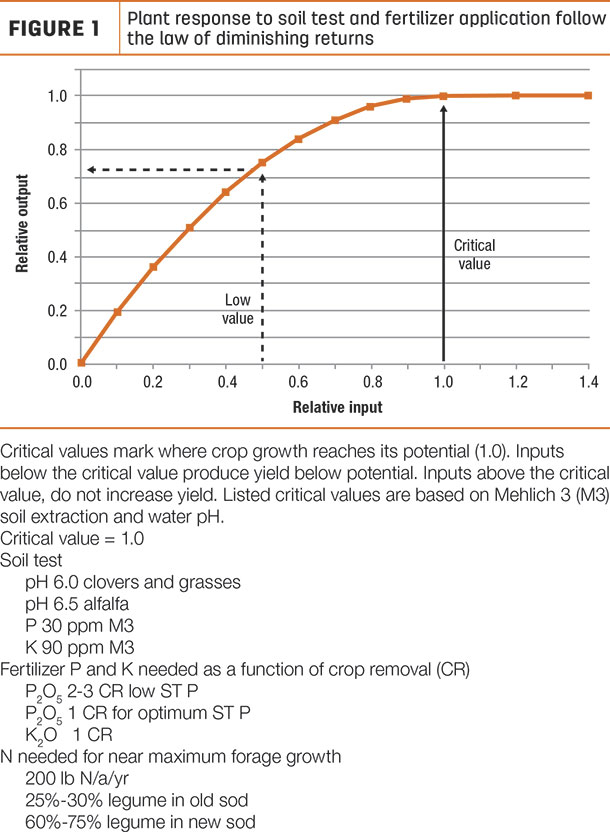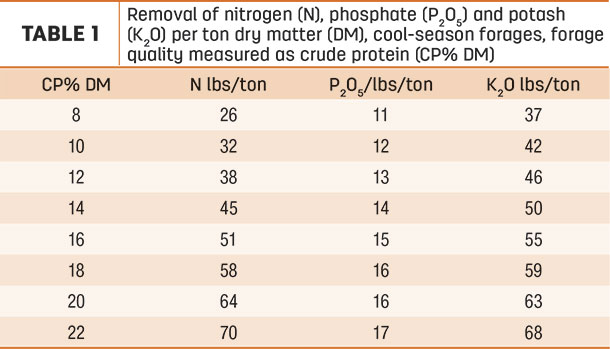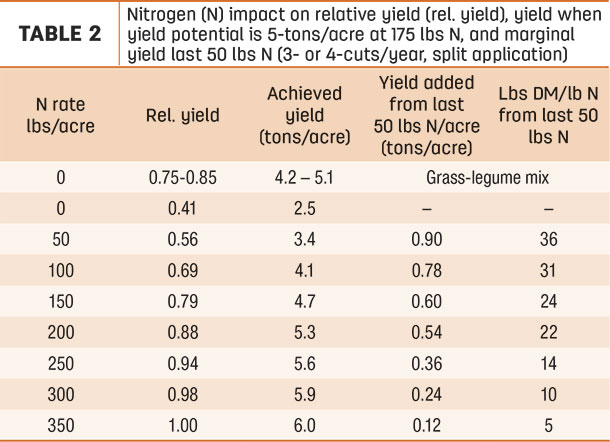Cattle producers are familiar with livestock nutrition. They need to know the animals’ nutrient requirements and forage test the hay fed to the animals.
Comparing the forage analysis to the requirements, they determine whether supplements are needed. Producers are less familiar with feeding the plants that provide hay and pasture. The principles are the same. What are the plants’ requirements and how much of the requirements can the soil provide? What supplements are needed to meet the requirements?
Plant response to soil P and K fertility
Without fertilizer, plant growth depends on soil fertility, measured by soil testing. Plants respond to nutrient input as a diminishing return (Figure 1).

Below a critical value (CV), the lack of a nutrient suppresses growth. Above that CV, adding more does not increase growth. When soil test phosphorus (P) is 15 parts per million (ppm), yield will be limited by available P and P should be added. When soil test P of 36 ppm, P does not limit yield and no added P is needed. The CV is the sweet spot where the lowest input of the nutrient achieves maximum crop growth.
Soil test numbers may differ between labs
Figure 1 CVs are elemental P and potassium (K) in ppm, using Mehlich 3 (M3) extraction. A soil sample sent to two labs may return different values due to the extraction method used and how values are reported. Labs reporting values as pounds per acre multiply ppm by two. Labs reporting values as phosphate (P2O5) and potash (K2O) use adjustment factors. To convert P to P2O, they multiply elemental P by 2.3. To convert K to K2O, they multiply elemental K by 1.2.
Plant response to added P and K fertilizer
To determine how much nutrient to apply, think in terms of crop removal. Crop removal is the product of yield and nutrient content. Measure hay yield by counting and weighing bales. Measure nutrient content by forage testing. Forage quality determines nutrient removal per ton (Table 1).

Low-quality hay containing 8% crude protein (CP) removes 26 pounds N, 11 pounds P2O5 and 37 pounds K2O per ton dry matter (DM). High-quality hay at 16% CP removes 51 pounds N, 15 pounds P2O5 and 55 pounds K2O per ton DM. Forage testing provides the moisture content. A 10-acre field produces 60 bales, at 750 pounds and 10% moisture (90% DM) yields just over 2 tons DM per acre (60 bales X 750 pounds per bale X (1 – 0.1 moisture) / 2,000 pounds per ton per 10 acres).
Soils testing above the CV need fertilizing at crop removal to maintain soil fertility. Soils testing below the CV need fertilizing at or greater than crop removal to achieve potential yields and to build soil fertility into the optimum range.
When soil test P is low, crops require two to three times potential crop removal to achieve potential yield. At low soil test P, part of the fertilizer P attaches to soil through a process called sorption, building soil test P but reducing crop response to added P. When soils test below the CV for potassium (K), applying K at potential crop removal rate achieves potential yield. Additional K is needed to build K fertility.
Grass response to N
Recommendations for N fertilization are based on field research (Table 1). There is low variability in relative yield response to N (plus or minus 10% covers 66% of observations) since environment impacts on plant growth act uniformly across N rates and grass species. For N-fertilized grass hay, we recommend 50 to 60 pounds N per acre per harvest for three to four hay cuts per year up to a maximum of 200 pounds N per acre per year. The maximum rate is set to reduce the risk of nitrate contaminating groundwater used from springs and wells or ending up down the watershed.
Grass-legume mixtures supply N
Legumes in grass-legume stands can provide N. In comparing N-fertilized grasses to grasses grown with legumes, fertilizer N increased yields up to 264 pounds N per acre per year, plateauing at 0.97 of maximum. Yield of grass-legume stands averaged 0.84 of maximum, equivalent to grass fertilized with 200 pounds N per acre per year. Alfalfa provided higher yields than red clover or birdsfoot trefoil, averaging 89% of maximum yield. In field trials, red clover averages 0.72 of alfalfa yield, and red clover and birdsfoot trefoil yields are equivalent (see Table 2).

Soil pH and liming
Soil pH needed depends on the legume grown. Most forages produce maximum yield when soil pH is above 6.0. Alfalfa, the exception, needs a pH above 6.5. For alfalfa, lime when the pH drops below 6.6. For grass-clover or trefoil stands, lime when the pH drops below 6.0.
Nutrient uptake and cycling
Farmers are often willing to fertilize crops but hesitate to fertilize pastures – an economic mistake. Fertilizing pastures gives the greatest return to fertilizer investment. Clover and livestock can recycle over 90% of P and K back to the soil. Distribution of urine and feces across the pasture is not uniform. Animals return K and N in the urine and P in the feces. Soil sampling different parts of the pasture (hilltops versus bottoms, bedding areas versus areas far from water), we can identify where nutrients are being mined and where they are being deposited. This tells us where to apply fertilizers. Moving mineral feeders can help control where more deposition is needed.
In feeding P and K to hay and pasture plants, remember their soil test CV and crop removal rate. Soils testing below the CV indicate yield will respond to adding that nutrient. Soils testing above the CV only need the nutrient applied at crop removal rate to maintain fertility. With proper liming to maintain soil pH and harvest management to favor legumes, legumes can provide N. Proper feeding and managing plants is the foundation for feeding livestock, people and the soil.









